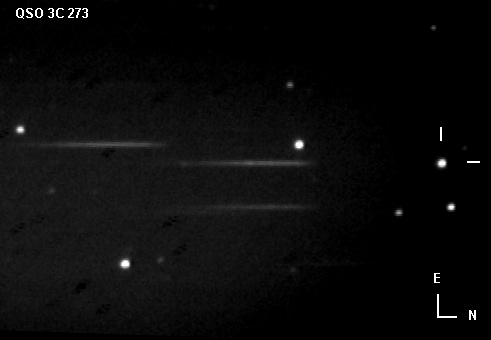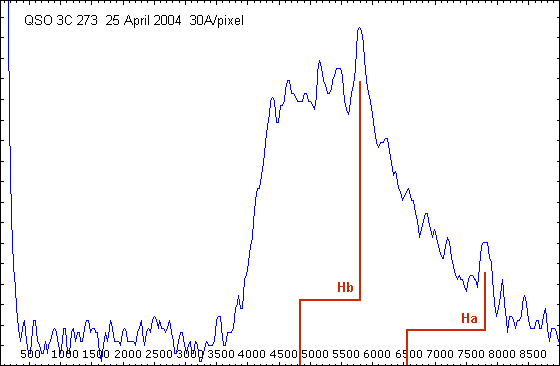
SPECTROSCOPY
MEASURING THE COSMOLOGICAL REDSHIFT OF QUASAR 3C 273
25th April 2004
According to the big bang theory of the evolution of the universe, the universe is expanding. Evidence for this is seen in the stretching of the wavelength of light from distant objects due to the expansion of space during the light's journey (the cosmological red shift)
QSO (Quasars) are extremely luminous objects which can be detected over vast distances using modest equipment. The brightest QSO is 3C 273 at magnitude 12.8. This is bright enough to be able to produce a spectrum using the 100 l/min grating, VC200L and 1004x-JG camera.

VC200L at f6.3 40 x 30sec
It is possible to identify Hydrogen alpha and beta emmision lines in the spectrum, but these are significantly shifted towards the red, as expected for such a distant object.


The red shift z is given by the fractional shift in the spectrum from their expected position
ie for the identified lines
z(H-b) = (5768-4861)/4861 = 0.187 z(H-a) = (7778-6563)/6563 = 0.185
Mean z = 0.186
This is comparable to but somewhat higher than the published figure for 3C273 of 0.158
Update 14th October 2004
Since the original observation, and at the suggestion of Dr Peter Newman (Apache Point Observatory), a cross check of the spectrometer calibration has been made using Hydrogen Balmer absorption lines visible in two stars close to the quasar in the original image (One can be seen to the left of the quasar in the (cropped) image above, the other is just off the top of the image) Based on this recalibration, the dispersion in the above spectrum is found to be 29.3 not 30 A/pixel as labelled. Once the measured redshifted Ha alpha and H beta wavelengths are corrected for this error, the resulting calculated redshift for 3C273 is 0.159, in good agreement with the calculated figure
By assuming a value for the Hubble constant, it is possible to use the red shift to calculate the distance to 3C 273. It works out at over 2 billion (10^9) light years. For the QSO to be so bright at such a distance, the luminosity must be about 100 times that of all the stars in the Milky Way combined!
RETURN TO SPECTROSCOPY INTRODUCTION